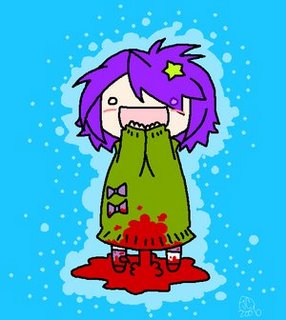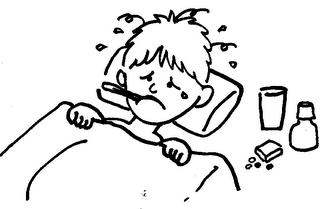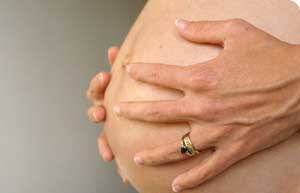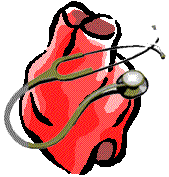menses fever

What is menstruation?
Menstruation is a woman's monthly bleeding. It is also called menses, menstrual period, or period. When a woman has her period, she is menstruating. The menstrual blood is partly blood and partly tissue from the inside of the uterus (womb). It flows from the uterus through the small opening in the cervix, and passes out of the body through the vagina. Most menstrual periods last from three to five days.
What is the menstrual cycle?
Menstruation is part of the menstrual cycle, which helps a woman's body prepare for the possibility of pregnancy each month. A cycle starts on the first day of a period. The average menstrual cycle is 28 days long. However, a cycle can range anywhere from 23 days to 35 days.
The parts of the body involved in the menstrual cycle include the brain, pituitary gland, uterus and cervix, ovaries, fallopian tubes, and vagina. Body chemicals called hormones rise and fall during the month and make the menstrual cycle happen. The ovaries make two important female hormones, estrogen and progesterone. Other hormones involved in the menstrual cycle include follicle-stimulating hormone (FSH) and luteinizing hormone (LH), made by the pituitary gland.
What happens during the menstrual cycle?
In the first half of the menstrual cycle, levels of estrogen rise and make the lining of the uterus grow and thicken. In response to follicle-stimulating hormone, an egg (ovum) in one of the ovaries starts to mature. At about day 14 of a typical 28-day cycle, in response to a surge of luteinizing hormone, the egg leaves the ovary. This is called ovulation.
In the second half of the menstrual cycle, the egg begins to travel through the fallopian tube to the uterus. Progesterone levels rise and help prepare the uterine lining for pregnancy. If the egg becomes fertilized by a sperm cell and attaches itself to the uterine wall, the woman becomes pregnant. If the egg is not fertilized, it either dissolves or is absorbed into the body. If pregnancy does not occur, estrogen and progesterone levels drop, and the thickened lining of the uterus is shed during the menstrual period.
In the illustration below, an egg has left an ovary after ovulation and is on its way through a fallopian tube to the uterus.
diagram of the uterus
Image Source: U.S. Food and Drug Administration
What is a typical menstrual period like?
During the menstrual period, the thickened uterine lining and extra blood are shed through the vaginal canal. A woman's period may not be the same every month, and it may not be the same as other women's periods. Periods can be light, moderate, or heavy, and the length of the period also varies. While most menstrual periods last from three to five days, anywhere from two to seven days is considered normal. For the first few years after menstruation begins, periods may be very irregular. They may also become irregular in women approaching menopause. Sometimes birth control pills are prescribed to help with irregular periods or other problems with the menstrual cycle.
Sanitary pads or tampons, which are made of cotton or another absorbent material, are worn to absorb the blood flow. Sanitary pads are placed inside the panties; tampons are inserted into the vagina.
What kinds of problems do women have with their periods?
Women can have various kinds of problems with their periods, including pain, heavy bleeding, and skipped periods.
*
Amenorrhea - the lack of a menstrual period. This term is used to describe the absence of a period in young women who haven't started menstruating by age 16, or the absence of a period in women who used to have a regular period. Causes of amenorrhea include pregnancy, breastfeeding, and extreme weight loss caused by serious illness, eating disorders, excessive exercising, or stress. Hormonal problems (involving the pituitary, thyroid, ovary, or adrenal glands) or problems with the reproductive organs may be involved.
*
Dysmenorrhea - painful periods, including severe menstrual cramps. In younger women, there is often no known disease or condition associated with the pain. A hormone called prostaglandin is responsible for the symptoms. Some pain medicines available over the counter, such as ibuprofen, can help with these symptoms. Sometimes a disease or condition, such as uterine fibroids or endometriosis, causes the pain. Treatment depends on what is causing the problem and how severe it is.
*
Abnormal uterine bleeding-vaginal bleeding that is different from normal menstrual periods. It includes very heavy bleeding or unusually long periods (also called menorrhagia), periods too close together, and bleeding between periods. In adolescents and women approaching menopause, hormone imbalance problems often cause menorrhagia along with irregular cycles. Sometimes this is called dysfunctional uterine bleeding (DUB). Other causes of abnormal bleeding include uterine fibroids and polyps. Treatment for abnormal bleeding depends on the cause.
At what age does a girl get her first period?
Menarche is another name for the beginning of menstruation. In the United States, the average age a girl starts menstruating is 12. However, this does not mean that all girls start at the same age. A girl can begin menstruating anytime between the ages of 8 and 16. Menstruation will not occur until all parts of a girl's reproductive system have matured and are working together.
How long does a woman have periods?
Women usually continue having periods until menopause. Menopause occurs around the age of 51, on average. Menopause means that a woman is no longer ovulating (producing eggs) and therefore can no longer become pregnant. Like menstruation, menopause can vary from woman to woman and may take several years to occur. Some women have early menopause because of surgery or other treatment, illness, or other reasons.
When should I see a health care provider about my period?
You should consult your health care provider for the following:
*
If you have not started menstruating by the age of 16.
*
If your period has suddenly stopped.
*
If you are bleeding for more days than usual.
*
If you are bleeding excessively.
*
If you suddenly feel sick after using tampons.
*
If you bleed between periods (more than just a few drops).
*
If you have severe pain during your period.
How often should I change my pad/tampon?
Sanitary napkins (pads) should be changed as often as necessary, before the pad is soaked with menstrual flow. Each woman decides for herself what is comfortable. Tampons should be changed often (at least every 4-8 hours). Make sure that you use the lowest absorbency of tampon needed for your flow. For example, do not use super absorbency on the lightest day of your period. This can put you at risk for toxic shock syndrome (TSS). TSS is a rare but potentially deadly disease. Women under 30, especially teenagers, are at a higher risk for TSS. Using any kind of tampon - cotton or rayon of any absorbency - puts a woman at greater risk for TSS than using menstrual pads. The risk of TSS can be lessened or avoided by not using tampons, or by alternating between tampons and pads during your period.
The Food and Drug Administration (FDA) recommends the following tips to help avoid tampon problems:
*
Follow package directions for insertion.
*
Choose the lowest absorbency for your flow.
*
Change your tampon at least every 4 to 8 hours.
*
Consider alternating pads with tampons.
*
Know the warning signs of toxic shock syndrome (see below).
*
Don't use tampons between periods.
If you experience any of the following symptoms while you are menstruating and using tampons, you should contact your health care provider immediately:
*
High fever that appears suddenly
*
Muscle aches
*
Diarrhea
*
Dizziness and/or fainting
*
Sunburn-like rash
*
Sore throat
*
Bloodshot eyes













